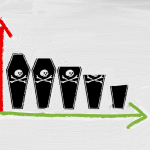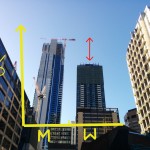Two-speed tax decrease
| *There is a break in series in 1981, as figure prior to 1981 are “Average Male Income”, and figures since 1981 are “Total Average Income” |
Although the difference is small from one year to the next, a twenty year time-line clarifies the point. While the average income in 1990 was $25,910 (falling within a tax bracket of 38.5%), 2011’s average income was $54,700, attracting the top tax rate of 47% back in 1990.
Income tax is a complex beast with many aspects including levies and rebates changing year to year. In an attempt to simplify the history of income tax in Australia, the following graph displays the percentage of tax paid for different multiples of the average wage from the inception of the Australian dollar onwards.
| *The resident Prime Minister is only indicative, as their timing doesn’t line up nicely with the financial years. |
Other than a very curious bump in the late seventies*, the years since have not provided much excitement. The slow and gradual “ramp-up” through the nineties is explained by almost a decade of non-updated tax rates, similarly to a small bump in the early to mid ‘naughties’ (2001-2004). Otherwise it has been a steady decrease of income taxes since Malcolm Fraser’s first term.
Generally speaking, income taxes have decreased over the past few decades. This decrease, however, is not evenly spread across the pay brackets. While the average wage now gets taxed about 4 percentage points less than thirty years ago, people earning 3, 4 and 5 times the average wage have experienced decreases of 9, 11 and 12 percentage points. This trend is even more pronounced if we used 1985-6 as the base year. Since Hawke’s first term in office, income tax on the average wage has decreased 2 percentage points, while those earning over 3 times the average wage have experienced a 14 percentage point drop in their income tax!
Interestingly, people earning half the average wage are still paying roughly the same levels of tax as they did in the late 70s, hovering around the 12%.
Of course, none of this includes the impact of tax breaks for Low Income Earners, nor does it include negative gearing or other benefits offered through our tax system. It is purely a simple model of calculating income tax percentages, by different multiples of the average wage.
The picture it tells appear lopsided, though mostly because there seems to be no other side in modern Australian politics.
_________________________
For references:
Tax brackets were sourced from the Australian Taxation Office’s (ATO) website:
http://www.ato.gov.au/individuals/content.aspx?doc=/content/73969.htm
Average Income from the ABS’ Average Weekly Earning’s publication:
http://www.abs.gov.au/Ausstats/abs@.nsf/0/14CDB5CD59F6A075CA2575BC001D6157?OpenDocument

















Thanks Seb, an enlightening post. Even with a glass of wine in me, your explanation and charts make sense to me.
Thanks for the comment Musings!
I find a glass of wine gives the charts the right level of 'perceived accuracy'. Every graph should be just a little blurry. Call it a 'confidence interval'.